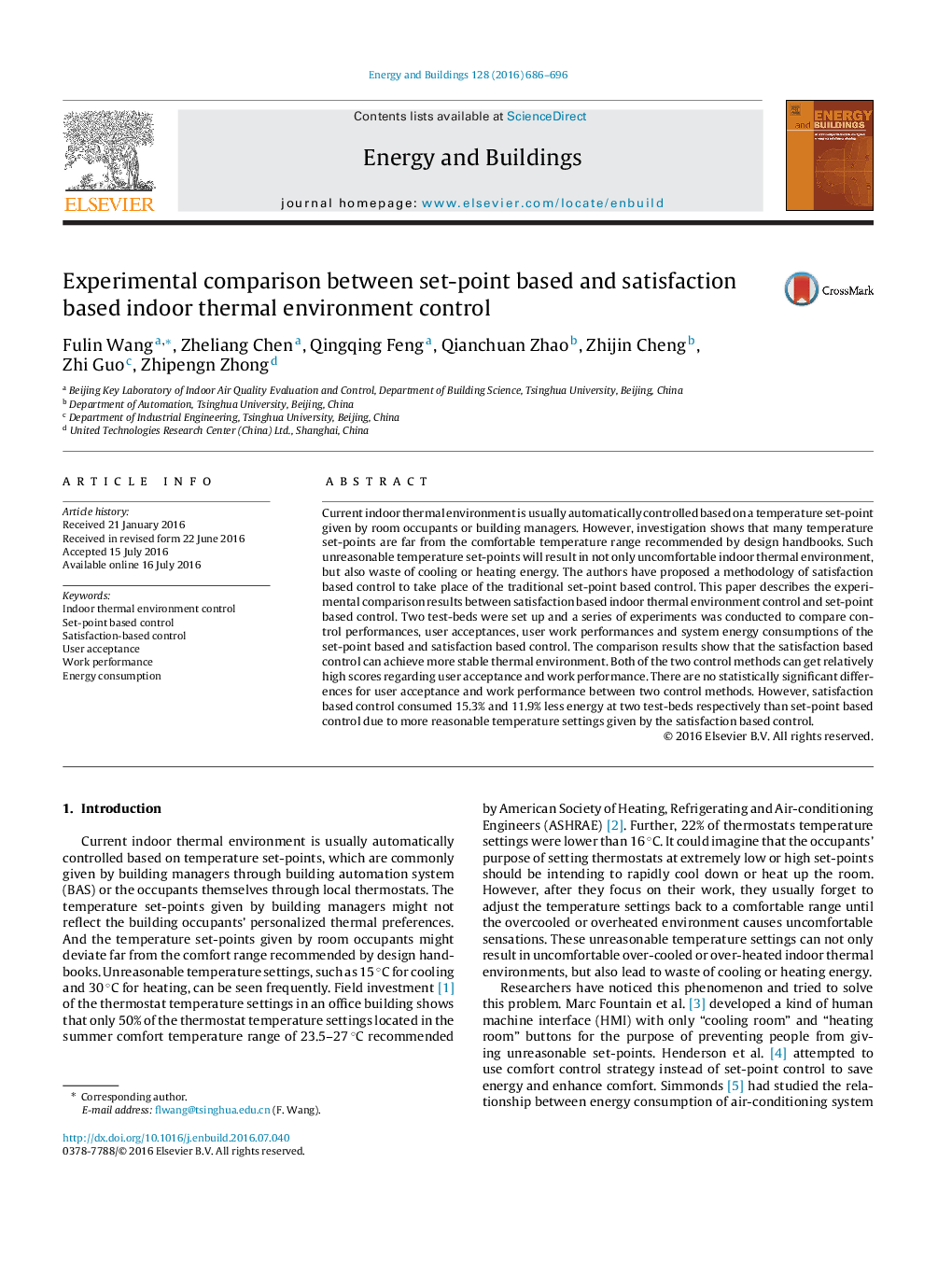| کد مقاله | کد نشریه | سال انتشار | مقاله انگلیسی | نسخه تمام متن |
|---|---|---|---|---|
| 6729894 | 504005 | 2016 | 11 صفحه PDF | دانلود رایگان |
عنوان انگلیسی مقاله ISI
Experimental comparison between set-point based and satisfaction based indoor thermal environment control
ترجمه فارسی عنوان
مقایسه تجربی بر اساس محدوده تعیین شده بر اساس رضایتمندی محیط کنترل حرارتی محیطی
دانلود مقاله + سفارش ترجمه
دانلود مقاله ISI انگلیسی
رایگان برای ایرانیان
کلمات کلیدی
کنترل محیط داخلی حرارتی، کنترل بر پایه نقطه، کنترل مبتنی بر رضایت، پذیرش کاربر، عملکرد کار، مصرف انرژی،
ترجمه چکیده
محیط داخلی حرارتی فعلی معمولا به طور خودکار بر اساس یک درجه حرارت تنظیم شده توسط ساکنان اتاق یا مدیران ساختمان کنترل می شود. با این حال، تحقیقات نشان می دهد که بسیاری از تنظیمات درجه حرارت از محدوده دما راحت توصیه شده توسط کتابچه های راهنمای طراحی است. چنین مقادیر غیرمعمول تنظیم دما باعث ایجاد ناخوشایند در محیط حرارتی داخلی می شود، بلکه باعث تلف شدن انرژی خنک کننده یا حرارت می شود. نویسندگان روش شناختی از کنترل مبتنی بر رضایت را برای انجام کنترل مبتنی بر نقطه پایه سنتی پیشنهاد کرده اند. این مقاله نتایج تجربی مقایسه ای را بین کنترل محیط محیط حرارتی داخلی و کنترل بر پایه نقطه رضایت مندرج در نظر می گیرد. دو تست تخت ساخته شد و یک سری از آزمایشات برای مقایسه عملکرد کنترل، پذیرش کاربر، عملکرد کار کاربر و مصرف انرژی انرژی سیستم مبتنی بر نقطه پایه و رضایت مبتنی بر انجام شد. نتایج مقایسه نشان می دهد که کنترل مبتنی بر رضایتمندی می تواند محیط پایدارتری را به دست آورد. هر دو روش کنترل می توانند نمرات نسبتا بالا در مورد پذیرش کاربر و عملکرد کار را بدست آورند. برای پذیرش کاربر و عملکرد کاری بین دو روش کنترل اختلاف آماری معنیداری وجود ندارد. با این وجود، کنترل رضایتمندی به ترتیب با استفاده از کنترل رضایتمندی، با مصرف 15.3٪ و 11.9٪ انرژی کمتر از دو تست تخت به ترتیب به ترتیب با استفاده از تنظیمات پایه با توجه به تنظیمات دما مناسب تر انجام شد.
موضوعات مرتبط
مهندسی و علوم پایه
مهندسی انرژی
انرژی های تجدید پذیر، توسعه پایدار و محیط زیست
چکیده انگلیسی
Current indoor thermal environment is usually automatically controlled based on a temperature set-point given by room occupants or building managers. However, investigation shows that many temperature set-points are far from the comfortable temperature range recommended by design handbooks. Such unreasonable temperature set-points will result in not only uncomfortable indoor thermal environment, but also waste of cooling or heating energy. The authors have proposed a methodology of satisfaction based control to take place of the traditional set-point based control. This paper describes the experimental comparison results between satisfaction based indoor thermal environment control and set-point based control. Two test-beds were set up and a series of experiments was conducted to compare control performances, user acceptances, user work performances and system energy consumptions of the set-point based and satisfaction based control. The comparison results show that the satisfaction based control can achieve more stable thermal environment. Both of the two control methods can get relatively high scores regarding user acceptance and work performance. There are no statistically significant differences for user acceptance and work performance between two control methods. However, satisfaction based control consumed 15.3% and 11.9% less energy at two test-beds respectively than set-point based control due to more reasonable temperature settings given by the satisfaction based control.
ناشر
Database: Elsevier - ScienceDirect (ساینس دایرکت)
Journal: Energy and Buildings - Volume 128, 15 September 2016, Pages 686-696
Journal: Energy and Buildings - Volume 128, 15 September 2016, Pages 686-696
نویسندگان
Fulin Wang, Zheliang Chen, Qingqing Feng, Qianchuan Zhao, Zhijin Cheng, Zhi Guo, Zhipengn Zhong,
